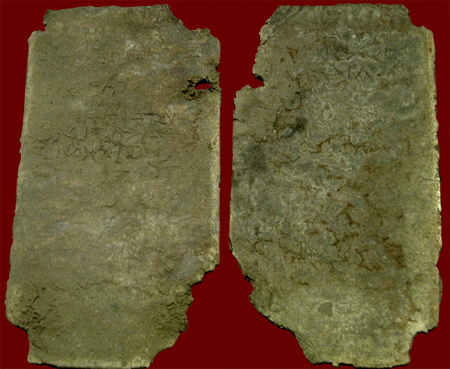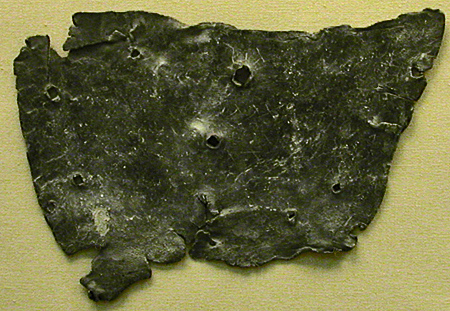
Lead curse tablets, once linked together (detail of the cursive script); Phrygia, 1-3rd century CE
Ancient magic is commonly associated with women, both as practitioners (sagae, veneficae, cantatrices) and patrons, the assumption being that women were more likely than men to resort to magical practices (magicae artes, maleficium, veneficium). References to witchcraft occur in Roman literature in such widely divergent texts as Apuleius' Metamorphoses and his Apologia, Propertius' Elegiae I.1, Ovid's Fasti 2.572-583, and Pliny the Elder's Historia Naturalis XXX. Although ancient magic has some superficial resemblance to religion, the differences are fundamental — religion is an open and public attempt to communicate with and propitiate the gods, while magic operates in secret and seeks to manipulate supernatural powers for personal advantage, frequently in order to harm one's enemies (e.g., Medea, Circe). Individual Romans, particularly in the lower classes, sought out witches, but the official Roman response was fear, and magic was condemned as a threat to civic order (Lex Cornelia, 81 BCE). Ancient magic took many forms, most of them Greek in origin, from charms and spells to potions and figurines, amulets and curse tablets (defixiones), which have been found throughout the Roman Empire (e.g. Britain). Although they are rarely dated, curse inscriptions are a unique source of information about oral Latin and literacy; they are sources for the voices of humble women, who had few avenues for written expression. Curses were written on wax, broken pottery, or lead, materials from the earth and thus closely connected to the underworld. Lead was hammered into a thin sheet, inscribed with a stylus, often folded or rolled and then pierced with a special nail to "fix" its power (defigo); the tablet might be placed in a sealed lead container by itself or with other materials, deposited in still or running water or in a pit or grave, or affixed flat to the wall of a shrine. Inscriptions often petitioned divine assistance for retribution when the law was insufficient to the task: avenging the loss or obtaining the return of someone or something (see Saturnina's memo to Mercury at the god's cult site in Uley), punishing rivals, betrayers, perjurers. Deities commonly invoked were those connected in some way to the underworld: Hekate, Hermes/Mercury, Pluto, Persephone, or local spirits. Below are three illustrated curse texts.
This tablet is a rectangular tin/lead alloy sheet approximately 3" x 2", left flat and not punctured, though slightly damaged in the lower left corner and upper center (drawing; Britannia XII, 1981:378). It was inscribed on one side with a pointed stylus in cursive script datable to some time after 200 CE (e.g.Vindolanda script) then tossed into the hot spring of the goddess for her safe-keeping. Unlike the two examples below, this is a preemptive curse that threatens mortal punishment for named individuals of a family should they break the oath they had sworn at the goddess's shrine. This is one of more than 100 curse tablets excavated from the sacred spring of Sul-Minerva in the Celtic-Roman town of Aquae Sulis (Bath, England). While its thermal springs were in use from neolithic times, the Celts, arriving in Britain around 700 BCE, erected what are believed to be the first shrines at the spring. Dedicated to Sulis, an ancient local water goddess, the shrine was a religious center for the peoples of southwestern Britain. With the arrival of the Romans in 43 CE, Sulis became fused with the Roman goddess Minerva as a healing deity (Sulis-Minerva). From about 65 CE and for nearly four centuries afterwards the Romans built increasingly elaborate bathing and temple complexes at this site.
Uricalus, Do[c]ilosa uxor sua,
Docilis filius suus et Docilina,
Decentinus frater suus, Alogiosa,
nomina <a> eorum qui iuraverunt.
qui iuraverunt ad fontem deae Suli[s]
prid[i]e Idus Apriles. quicumque illic per-
iuraverit deae Suli facias illum
sanguine suo illud satisfacere.

Lead curse tablet, early 1st century CE
This lead tablet, excavated in downtown London in 1934, was cut from a plate that originally protected part of a building structure; as lead was a favored material (probably for its ease of inscription, dark color, and durability), pieces of pipe and scrap metal were often the curse-maker's quarry. The author of the curse hammered the plate into a thin, roughly rectangular sheet (7" x 4 3/4") and scratched it with a sharp instrument (stylus) in cursive script (drawing; JRS XXV, 1935:226). Then s/he (gender unknown) pierced the plate with seven nail holes (seven being a magic number), driven in from the blank side (magic nails). The text, as a result of the minimal literacy of the inscriber and its treatment for magical potency, is defective but its intent is clear. The reason for the punishment invoked is often not stated, as here, the assumption being that the deity well knows the cause. The accursed, Tretia Maria, is threatened in detail with total inability to function, in particular her ability to reveal secrets. Damaged letters and careless script make the conclusion of the curse unintelligible. A larger tablet containing a powerful curse of this type was found in South Latium in a deposit together with items of black magic.
illeus vita[m] et me[n]tem
et memoriam [e]t iocine|ra
sci [=sic] no[n] possit<t> loqui
[quae] sicreta si[n]t neque . . .
. . . possit neque . . .
. . . .
This lead curse tablet from Kreuznach (Germany) was found in a tomb, where it lay hidden at the bottom of a glass vessel together with the ashes of bones. Dated to the year 900 CE, it gives evidence of how persistent the practice of defixiones was. It is unusual in that it is round (1.89" in diameter), has no nail hole, and is written on both sides of what may have originally been the cover of a container (see drawing: side A, side B). On one side the text consigns persons (nomina data) to the underworld spirits (ad inferos) with no explanation for their condemnation. Read aloud, the rhythm and end-rhyme of the words (data, delata, legata) create a sing-song pattern that was believed to promote the curse's efficacy, as in incantations and chants (binding curses like this Circus curse make use instead of cryptic forms of writing and visual entanglement). On the back or inside of the disk were inscribed both the names and the probable cause of the curse (a love triangle); missing letters and the absence of a verb of cursing make this a puzzling and contested text—often the situation in interpreting curse tablets. The inscription closes with an unexpected declaration of love by the author of the curse.
| Side A | Side B |
| Nomina | Silonia |
| data [dela]|ta | Surum Cae-|nu[m] |
| l[egata] | Secundum. |
| ad inferos, | ille te |
| [ut] illos per vim | [s]ponsus pro|cat: |
| [c]orrip[i]ant. | il[l]um amo. |
Click on the underlined words for translation aids and commentary, which will appear in a small window.